By Jon Diamond
On a cold March evening in the Goldenrod Café in West Point, Nebraska, Mary Timmermann, a waitress there, picked up the telephone receiver when her boss told her it was Omaha calling long distance for her. She immediately panicked because she had a son, Karl, who had been wounded fighting the Germans in Europe three months previously, and the mother thought the worst had now occurred.
The voice at the other end of the telephone line was not a War Department representative but rather a reporter from the Omaha World-Herald, who wanted to inform Mrs. Timmermann that her son, 2nd Lt. Karl H. Timmermann, commanding Company A, 27th Armored Infantry Battalion, 9th Armored Division’s Combat Command B (CCB), was the first American officer to cross the Rhine River at Remagen.
Not overly impressed with his daring feat of arms, Mrs. Timmermann was only concerned whether or not her son was hurt, or worse dead.
SHAEF’s Plan to Cross the Rhine
The Rhine has for centuries been Germany’s natural barrier to invasion from the west. Broad and swiftly flowing, it is a formidable obstacle to attacking armies, and the few bridges that cross it are choke points that restrict the size and speed of invading armies.
The Rhine, some sources say, begins its 766-mile seaward journey high in the Alps at Lake Toma, Switzerland. From its confluence with the Moselle River at Coblenz, the river flows northward through mountainous country as far north as Bonn, where it emerges from the hills into rolling countryside.
Halfway through the mountainous stretch lies the town of Remagen, just north of the point at which the Ahr River flows from the Eifel Mountains to the west. This rugged terrain confronted General Omar Bradley’s 12th Army Group, comprising General George S. Patton’s Third Army on the southern flank and General Courtney Hodges’ First Army to the north, in March 1945. The Americans agreed that this was not optimal country for armor, since tanks and trucks would be confined to the narrow, winding mountain roads.
For the Allied armies driving eastward in early March 1945, the Rhine River was the last topographic boundary in their assault on western Germany, which contained the industrial heartland of the Ruhr and the Saar. Intriguingly, General Dwight D. Eisenhower’s initial offensive plans after the conclusion of the Battle of the Bulge ignored a Rhine crossing in the American First Army’s sector, which included the small town of Remagen.
The rationale of the SHAEF (Supreme Headquarters Allied Expeditionary Force) commander was that the Rhine in this sector was not favorably viewed for river crossing operations since the eastern bank possessed 600-foot-high cliffs rising straight out of the river. Here the mountains on the east side quite literally fell into the water, making this a difficult place to cross the river and subsequently exploit a new bridgehead for a drive into the heart of Germany.
Farther beyond the cliffs lies the Westerwald—a forest with a primitive dirt road network that would be unsuitable for an armored advance. Also, the roads on the western bank leading to Remagen, 15 miles south of Bonn, were poor.
The Rhine is broad, deep, and with such a rapid current that the U.S. Army Corps of Engineers reported, “At no place is the river fordable, even at low water.” But the Allies also knew that the Rhine would have to be crossed. Thus, the Allied staff had been developing plans to cross the river even before the landings in Normandy in June 1944.
River-crossing schools were started on the Loire after the sweep across France. Several steel mills in Luxembourg were busy constructing metal beams for treadway bridges, and American boatyards were mass producing lightweight river craft that could carry a dozen GIs across the wide river. Seagoing landing craft, sturdy enough to transport tanks across the Rhine, were sent from England to the Rhineland via the port of Antwerp, Belgium.
Despite the vast collection at forward depots of assault boats, landing craft, motors, and enough steel beams and lumber pilings to erect dozens of bridges across the Rhine, everyone believed that capturing a bridge intact would be much simpler than building one, especially under tenacious fire from the Wehrmacht defending its last natural western barrier, which had not been successfully crossed during combat since the Napoleonic Wars.
A “Funnel” at Remagen
As early as February 1945, German Field Marshal Gerd von Rundstedt believed that the Rhine was an excellent natural obstacle to deter further Allied eastward advances. However, to mount a proper defense of the river, all the major bridges would need to be demolished after the Wehrmacht retreated across them.
The Germans took particular efforts to ensure that no Rhine bridges fell into Allied hands. German pioneers (sappers) timed their bridge demolition activities to permit as many escaping German troops as possible to get to the eastern side of the river before blowing them up.
Since the Nazi high command had regarded the Rhine as its final western defense line and, accordingly, had been destroying all the bridges across the great river to prevent their capture by the Allies, SHAEF knew that an amphibious river crossing operation across the Rhine would be needed—but not in First Army’s sector where Remagen stood. That was reserved for Field Marshal Bernard Montgomery’s 21st Army Group farther north.
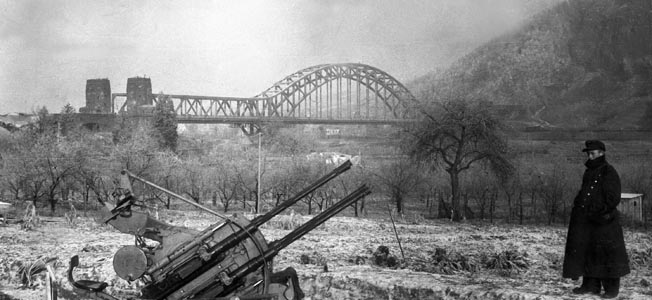
General Gustav von Zangen’s Fifteenth Army staff was at odds with SHAEF’s assessment and believed that the advancing Americans would take advantage of the open terrain of the Rheinbach Valley toward the Ahr River. Zangen himself firmly believed and argued with German Army Group B commander Field Marshal Walter Model, “The Americans would have to be stupid not to take advantage of this hole and push tanks toward the Rhine. I think they will use this valley—like water flowing downhill.”
Zangen predicted that the Americans would take advantage of this natural funnel for military operations and viewed Sinzig and Remagen on the Rhine as probable targets for Hodges’ First Army. The real danger, Zangen correctly predicted, was the outlet of the “funnel” at Remagen, and he wanted to block the Americans by withdrawing two corps from the West Wall defenses along the German frontier and placing them at Remagen to protect the Ludendorff Bridge.
At the height of World War I in 1916, construction was begun on the Ludendorff Railroad Bridge by Russian prisoners of war; it was finished three years later at a cost of over two million marks. The 1,200-foot-long structure’s span consisted of symmetrical arches adjoining four stone-towered abutments and was wide enough for two trains to pass abeam. If motor traffic were required to use the bridge, wooden planks could be laid over the tracks to form a roadbed.
On the east bank of the Rhine, the train tracks entered a tunnel bored through a steep, 600-foot cliff named Erpeler Ley, on top of which, in 1945, was an array of antiaircraft guns. Explosives had been fitted to the bridge by the defenders and linked by cables through heavy conduits to an electrical firing switch located inside the eastern bank’s tunnel.
Zangen still needed the bridge as a supply route, or, if his defenses cracked, as a last-minute escape route across the Rhine. Even Model, in keeping with the American planners’ thinking, realized, “Only a fool would try to cross the Rhine where the cliffs rose steeply on the opposite bank,” thus he refused to allocate more troops to Zangen’s Remagen sector.
Model contended that the main American thrust would be against Bonn. Once the U.S. First Army started moving eastward again, after the German Ardennes offensive had failed, Model sent one of his few mobile reserves, Panzer Brigade 106, to Bonn.
The German military was reeling after the horrendous losses incurred during the Battle of the Bulge, in which more than 500,000 troops were killed during the Ardennes offensive and against the Soviets on the Eastern Front. Young teenage boys, old men, and even women were now serving as combatants against the Allied advance on both fronts.
Thus the German Fifteenth Army, which was defending a long section of the West Wall 25 miles west of Remagen, would have to make do without any reinforcements. According to historian Charles Whiting, “The bridge was left virtually undefended, save for a handful of engineers, members of the local home guard, and a few infantrymen. It was a fatal oversight. For against all military good sense, the Americans would indeed attempt to cross the bridge at Remagen.”
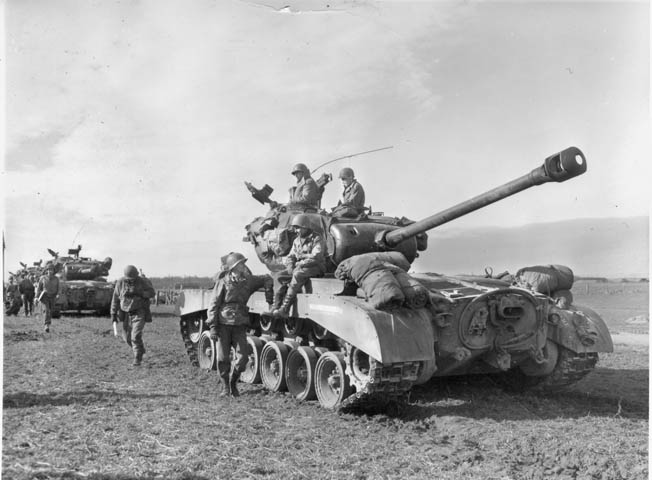
Depleted infantry rosters were not the only shortages among Zangen’s Fifteenth Army in the Rhine sector in early March 1945. His 9th Panzer Division had less than 40 tanks and assault guns, while the once vaunted Panzer Lehr Division had only 50. The entire Fifteenth Army could muster only 300 tanks and assault guns.
The German command structure at Remagen was also chaotic. Remagen was part of Wehrkreis XII stationed in Wiesbaden, but the conduct of defensive operations in the Remagen area was initially the responsibility of General Kurt von Berg of Wehrkreis XII Nord, headquartered at Coblenz.
However, on March 1, 1945, command at the Remagen Bridge was relegated from Wehrkreis XII Nord to General Walter Botsch’s command in the Bonn sector, reflecting Model’s fear of an American assault on Bonn. The district had its own engineer regiment, Landes Pioneer Regiment 12 (Ld.Pi Rgt 12), and the Remagen area was the responsibility of its third battalion, commanded by Major August Kraft, headquartered at Bendorf-Sayn.
This engineer unit was made up of older soldiers, many of whom were veterans of World War I and unfit for regular combat units. The engineers were responsible for preparing the Rhine bridges for demolition and were also heavily involved in the operation of ferries to help evacuate troops from the west bank of the Rhine to the east.
The bridge itself was the responsibility of the 12th Company of Ld.Pi Rgt. 12 commanded by Captain Carl Friesenhahn, with just over 100 men. A convalescent company of 140 recuperating men was commanded by Luftwaffe Captain Willi Bratge, who had suffered three wounds on the Eastern Front.
To Seize the “Black Line”
On March 3, Maj. Gen. John Milliken’s III U.S. Corps had been ordered by First Army commander Lt. Gen. Courtney Hodges to head for the Ahr River and link up with Patton’s Third Army. The job of seizing the main road junction at Euskirchen fell to Maj. Gen. John Leonard’s 9th Armored Division, a part of III Corps, with only token resistance being encountered. This, as Zangen feared, opened up the Rheinbach Valley to Milliken’s III Corps.
Leonard was a hard-charging commander, having earned the Distinguished Service Cross as an infantry battalion commander during World War I. He had been wounded at Verdun and received the Purple Heart plus two French decorations.
On March 6, III Corps advanced through the Rheinbach Valley, overrunning German ammunition dumps and capturing a number of ammunition supply vehicles, which severely hampered Fifteenth Army’s resupply of heavier ordnance.
Zangen’s attempts to slow the movement of III Corps became fruitless, so he allowed many elements of Fifteenth Army to withdraw toward Bonn late that day, making Remagen an even easier and more attractive target.
The Germans were currently holding both sides of the Rhine, but on the west bank they were at widely separated places covering the most likely crossing points at Bonn and Coblenz. Between them was a 60-mile gap around Remagen, virtually undefended because Model thought the mountainous country beyond Remagen would dissuade the Americans from crossing there.
General Walter Botsch had ordered that demolitions be replaced on the Ludendorff Bridge on March 6, after they had previously been removed to prevent accidental detonation and bridge destruction by Allied bombs before all German troops heading eastwards could cross the Rhine.
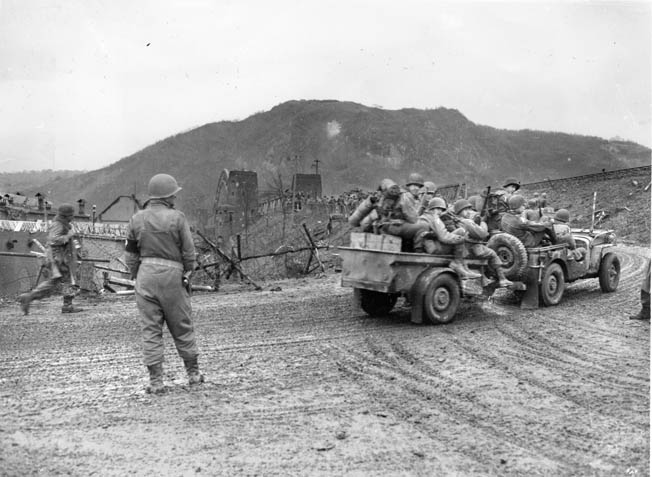
On the bridge’s access ramp at the western end was a large explosive charge of Donarit—a compound made of 80 percent ammonium nitrate, 12 percent trinitrotoluene (TNT), and a variable amount (2-8 percent) of nitroglycerine—controlled by a separate detonator and placed to crater the ramp and stop vehicles. A series of other charges were placed to bring down the bridge’s center and easternmost span and were controlled by another detonator.
To further compound the chaos of the German command structure for the defense of Remagen and the bridge, Botsch was replaced on March 6, literally hours before the lead elements of Brig. Gen. William Hoge’s Combat Command B (CCB) reached Remagen. Taking his place would be a major named Hans Scheller, but he had not yet arrived.
Zangen’s Fifteenth Army was still crossing the Ludendorff Bridge in a steady stream on March 6. The German defenses at the bridge clearly suffered from a lack of troops. The only potential resistance to the Americans would likely come from intermittent 20mm flak guns firing from across the river.
That same day, following Milliken’s orders, Leonard sent a mixed task force of tanks, infantry, and supporting vehicles—Combat Command B (CCB)—toward Remagen; Hoge’s CCB reached Meckenheim by the afternoon of the 6th and spent the day and evening clearing out the town; CCB was now within a day’s trek of the Rhine itself, in the vicinity of Sinzig and Remagen.
Before the war, Hoge had been a construction engineer working on the Alaska-Canada highway, so he had plenty of experience with roads and bridges. His previous combat experience included leading engineering formations on D-Day at Omaha Beach to clear obstacles while under fire. Hoge had also led the 9th Armored Division’s CCB defense of the Belgian town of St. Vith during the Battle of the Bulge.
A Piper Cub aircraft spotting for the 9th Armored Division’s artillery flew over the Ludendorff Bridge on March 6 and reported that it was not yet destroyed. At 11 pm, General Milliken told Leonard over the phone, “You see that black line on the map? If you can seize that, your name will go down in history.”
The “black line” Milliken was referring to was the Ludendorff Railroad Bridge over the Rhine River at Remagen.
M26 Pershings Charge Into Remagen
On March 7, 1945, Cologne fell to the Allies; however, that city’s link to the eastern bank of the Rhine, the 1,200-foot segment of the Hohenzollern Bridge, had been destroyed the previous day, making a Rhine crossing at Cologne impossible for Hodges’s First Army. The other Rhine spans, too, were destroyed by German demolition—all but one.
Hoge’s tanks, infantry, and other troops were again to be in the thick of it. Because of all the rubble blocking the roads around Meckenheim, they did not start their movement on March 7 until 10 am; they arrived outside Remagen just past noon.
Although Hoge’s initial orders had focused on a southeast movement toward the Ahr River, a western tributary of the Rhine a few miles south of Remagen, and made no reference to taking the Ludendorff Bridge or to gaining a bridgehead east of the Rhine, at 3:30 am on March 7 Leonard’s 9th Armored Division headquarters changed CCB’s mission.
Hoge conferred with Leonard, and they agreed that the opportunity should be taken if the Germans were foolish enough to leave a bridge intact. However, no one in III Corps expected that the Ludendorff Railroad Bridge would remain standing for much longer.
Hoge organized CCB into two columns, a northern one, under Lt. Col. Leonard E. Engeman, aimed at seizing both Remagen and Kripp, and a southern one responsible for Sinzig’s capture. Engeman’s task force was composed of the 14th Tank Battalion, 9th Armored Division, and elements of the 27th Armored Infantry Battalion, commanded by Major Murray Deeveis. General Leonard then ordered CCB to advance to the west bank of the Rhine and capture Remagen and Kripp as well as secure bridgeheads over the Ahr.
Concerned about broadcasting his orders over a radio when the enemy might be listening, Hoge sent Major Ben Cothran to Engeman’s northern column of CCB with orders to take the bridge if it still stood. By the time Cothran reached Engeman’s column, the lead elements had already cleared the woods west of Remagen and were sitting in a hilltop clearing overlooking the intact Ludendorff Bridge.
Engeman, after training his binoculars on the valley below, jumped with excitement at the sight of the still standing bridge. Through the morning fog, he was able to make out that the German engineers had, with wood planking, turned one set of tracks into a vehicle bridge. A long line of German vehicles was moving across the only still usable bridge over the Rhine within immediate American reach.
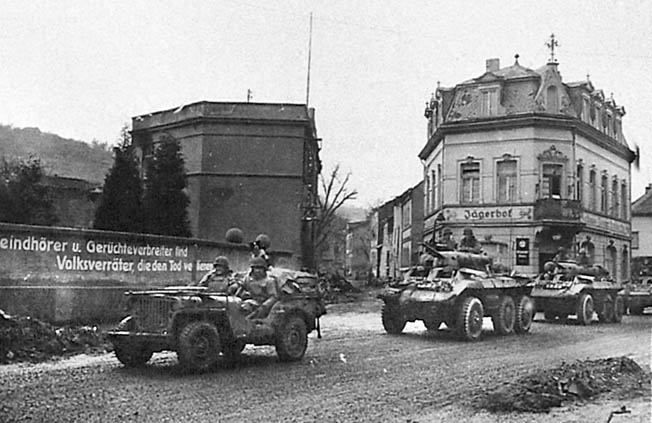
Engeman wasted no time. He summoned a platoon of the 14th Tank Battalion’s newly arrived M26 Pershing tanks with their long-barreled 90mm guns that, unlike the undergunned Shermans, could knock out anything the Germans could offer in combat. The tank platoon had arrived at the edge of Remagen before the infantry and, having encountered no resistance, simply pushed on into the town.
Brigadier General Hoge himself arrived at Remagen and, seeing firsthand the opportunity before him, urged his forces down through the town as fast as they could go.
Engeman, in turn, instructed Lieutenant Karl Timmermann’s Company A, 27th Armored Infantry Battalion (of which he had been in command for less than 24 hours): “Go down into the town. Get through it as quickly as possible and reach the bridge. The tanks will lead. The infantry will follow on foot. Their half-tracks will bring up the rear. Let’s make it snappy.”
Timmermann’s unit had been resting in an abandoned German Labor Corps camp situated on the heights just above Remagen. Staff Sergeant Joseph de Lisio, from New York City, issued orders to his tired fellow soldiers to get up and start moving.
The infantry set off down the hill overlooking the bridge at 1:20 pm, following the Pershings as they descended down a steep, tree-lined road into the town.
Timmermann noted that Remagen appeared deserted, and also observed the tanks moving toward the bridge. He and his men followed along the main road running through the center of town.
Ahead of him, the Pershings wheeled into firing position near the west end of the bridge, prepared to smash any opposition across the river. One of their first targets was a locomotive that was pulling a string of freight cars along the opposite bank; Grimball’s tanks opened up and knocked out the train.
The stage was set for the Americans’ coup de main—a violent, all-out assault on the objective. A CCB operations officer turned to the intelligence officer, wondering how a little combat command, having only one understrength tank battalion and an infantry battalion, could possibly cross the Rhine and defend the bridgehead until help arrived.
In one of innumerable ironic twists during World War II, Timmerman had been born in Frankfurt, Germany, in 1921—not more than 100 kilometers from the last bridge standing across Germany’s vaunted western natural barrier.
Karl’s father, John H. Timmermann, an American of German parentage who spoke German well, had been a private in the American Expeditionary Force’s 8th Infantry Regiment but had deserted from the U.S. Army Occupation Force in 1919 to his ancestral homeland and married a German woman. Eventually, the Timmermanns left Frankfurt and, with the assistance of American Quakers, were able to return to West Point, Nebraska. Karl had enlisted in the U.S. Army in 1940 in spite of the fact that he had uncles in the Wehrmacht.
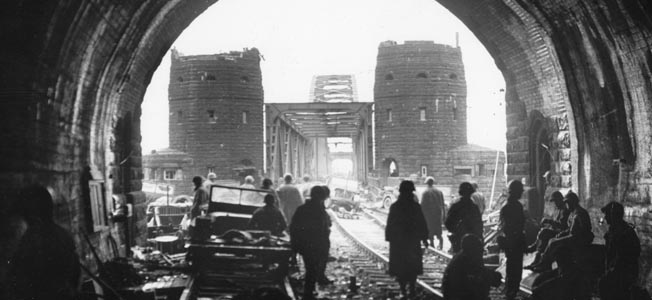
“Do You Know What the Hell River That Is?”
On the morning of March 7, the Germans’ new area commander, General Otto Hitzfeld, whose LXVII Corps headquarters were 35 kilometers from the bridge, ordered Major Hans Scheller to drive to Remagen and take charge of both the structure and any troops there. His orders were tentative; namely, preventing the Americans from capturing the bridge intact but also prohibiting any premature demolition of the bridge to allow as many men as possible in Hitzfeld’s LXVII Corps to safely retreat across the Rhine.
Scheller arrived at the bridge at 11 am, but he lacked any suitable radios to maintain contact with Hitzfeld’s command. Within minutes of his arrival, some American tanks were sighted heading toward Remagen, and Scheller’s new subordinates urged him to destroy the bridge.
Scheller did not want to demolish the bridge too soon and leave LXVII Corps stranded on the west bank of the Rhine; however, he instructed his engineers to finish their demolition preparations and wait for his orders to detonate the explosives.
At 1 pm, the Germans heard the tanks and small arms fire coming from Remagen. Despite pleas from his two junior officers—Captain Karl Friesenhahn, an engineer in charge of the bridge itself, and Luftwaffe Captain Willi Bratge, who commanded a small mixed force of antiaircraft and Volkssturm troops—to blow the bridge, Scheller hesitated. He could not yet see any American soldiers so he denied that request as well.
At about the same time, Company A was advancing past a bend in the road through the hills. Acting Sergeant Carmine Sabia from New York shouted, “Jesus, look at that…. Do you know what the hell river that is?”
It was the fabled Rhine. And spanning the broad, brown, swiftly flowing river was a magnificent sight: a bridge. The graceful curve of the bridge’s truss arch structure between the twin stone fortress-like towers at each end made for a picturesque view, and the long, gray line of German troops and vehicles streaming across the span gave life to the scene.
But none of the men in Timmermann’s unit was considering the aesthetics. What they were concerned about was their orders: to take this 1,200-foot-long bridge at all costs. Never mind that the whole thing might blow up in their faces when they were halfway across.
By 2 pm, the men of Company A, going doorway to doorway, had cleared most of the opposition in Remagen and were now turning their attention to the bridge itself. Timmermann’s men, deployed into three platoons, started a slow trek through the smoke surrounding the descending road leading to the western side’s twin bridge abutment towers.
“You’ve Got 45 Minutes to Take the Bridge”
At the same time, the main detonation circuit for the demolitions was completed, but a secondary one was not fully operational. A few minutes later the German engineers tested the main firing circuit and concluded that it was still functional. To bolster their defenses, the Germans had a barge sitting half submerged in the river about 200 yards upstream from the bridge and filled with armed soldiers.
Major Scheller and Captain Friesenhahn inspected the western side of the bridge at approximately 2:30. Within minutes of reaching the western end of the bridge, both German officers heard the Americans fighting their way through Remagen and coming closer. At 3:12, the American tanks, still at the western end of the bridge, started covering it with fire.
Under sporadic German rifle fire, Timmermann led his soldiers past the few remaining houses above the river and noted Germans on the other side, apparently preparing to detonate other explosives to destroy the bridge.
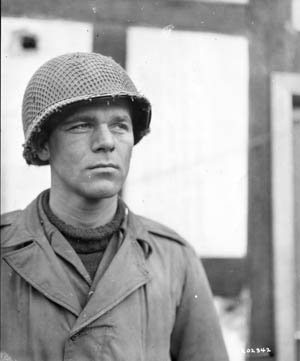
It was truly an irony of war that the Americans, who had little intention of capturing a bridge because Remagen was halfway between two previously selected crossing points, Bonn and Coblenz, were now poised to do so.
The Americans had just obtained information from German POWs captured early that afternoon claiming that the bridge was to be blown at 4 pm. The information was confirmed by several citizens of the town and was relayed to Brig. Gen. Hoge, who sent the following message to Colonel Engeman at 3:15 pm: “You’ve got 45 minutes to take the bridge.”
At this time, Friesenhahn ordered a charge under the approach ramp to the western side of the bridge be detonated; a tremendous explosion went off on the causeway with a thunderous whump, causing a plume of dirt and cobblestones to rise into the air and cratering the road surface with a 30-foot hole he hoped would keep American tanks from gaining the bridge from the west.
As Timmermann’s company hit the ground, the flying rubble cascaded down upon them. This large crater may have been capable of stopping vehicles but not the assaulting American infantry. With gunfire from the towers of the bridge now being directed at his advancing company, Timmermann told his GIs to fix bayonets, and they raced onto the bridge.
Back on the eastern side, Scheller gave the order for the engineers to set off the main detonator circuit inside the tunnel entrance, which controlled the demolitions for the center and eastern spans of the bridge. The main detonator circuit failed to work and, with only a partial secondary circuit controlling the charges on the eastern portion of the bridge at the stone pier, a German soldier ran about 100 yards onto the bridge to set off the primer cord to this device by hand.
Soon there followed another explosion two-thirds of the way across. Planks rose from the railway, and the bridge seemed to lift up. However, it settled with the structure still intact. It was unclear to the German officers why the explosives did not detonate properly to destroy the bridge but, afterward, American engineers found that the blasting cap had gone off in the second charge, but it had been placed too deep to set off the explosives.
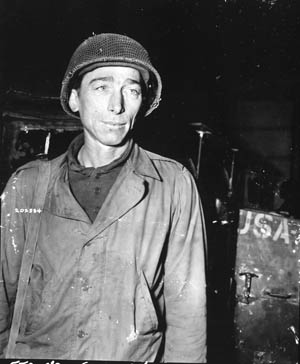
The First Americans Across the Rhine
Meanwhile, Lieutenant Timmermann was prodding his three reluctant infantry platoons to keep moving despite intense machine-gun fire coming from the towers on the eastern end of the bridge.
With snipers on the barge also posing a danger, Timmermann went back to a Sherman tank sitting near the crater that blocked the access ramp and asked for some fire support. The tank gunners obliged and quickly opened up on the barge; a white flag soon appeared.
On the bridge, the covering fire from American tanks should have enabled Timmermann’s men to advance, but he returned to find them immobilized, fearful that the bridge would blow up at any second. The lieutenant yelled at Sergeant DeLisio to get the men moving. DeLisio got up and started forward; his men followed. Next came the second platoon, led by Lieutenant Emmet J. Burrows. Their mission was to clear out the German machine-gun nests in the eastern towers.
By this time, the remainder of the 27th Armored Infantry Battalion had arrived. The armored infantrymen leaped from their vehicles and went into firing positions downstream from the bridge. The American assault guns and mortars began firing white phosphorus into Erpel, the village along the east bank of the river just north of the bridge, driving the defenders into cover.
The combat engineers of the 9th Armored Engineer Battalion also swung into action. Three members of the battalion (Lieutenant Hugh Mott, Sergeant Eugene Dorland, and S/Sgt. John Reynolds) dashed onto the bridge with Timmermann’s assault infantry to cut the demolition wires, preventing the Germans from touching off explosive charges planted on the crossbeams underneath.
These engineers soon learned how close they came to disaster; they located a 500-pound charge of Donarit about two-thirds of the way across the river. Its cap had gone off, but somehow the charge failed to explode. Lieutenant Mott and his two sergeants also found 350-pound charges that had not gone off in the bridge’s piers. One of the cables leading to the main charge had been severed, possibly by artillery.
Sergeant Dorland raced across the bridge and tried to cut a main explosive cable with pliers but, failing that, fired three shots from his carbine into the cable, smashing the line completely.
With most of the explosive charges now inert, the engineers were able to cut the lines for the remaining explosives to prevent accidental explosions, saving the bridge.
Timmermann and his men were still racing across the bridge, dodging bullets, cutting wires, and throwing explosive charges into the river. The lieutenant continually prodded his soldiers to keep going, to not give in to the temptation of seeking cover behind a steel beam.
Out of breath, Timmermann and a handful of his men finally reached the far side of the bridge. Enemy fire was still spitting from the twin stone towers, so DeLisio entered one tower at its base and charged up the circular staircase. At the top he came upon three Germans trying to clear a jam in their gun, fired a couple of shots, then took the men prisoner; he threw the weapon out of the tower’s gun port, then captured two more of the enemy, including a lieutenant. Simultaneously, three other GIs—named Chinchar, Samele, and Massie—were cleaning out the adjacent tower.
While this was taking place, Private Alex Drabik, leading a small pack of infantrymen, became the first American to set foot on the opposite side of the Rhine. Close behind were about 120 men from Company A.
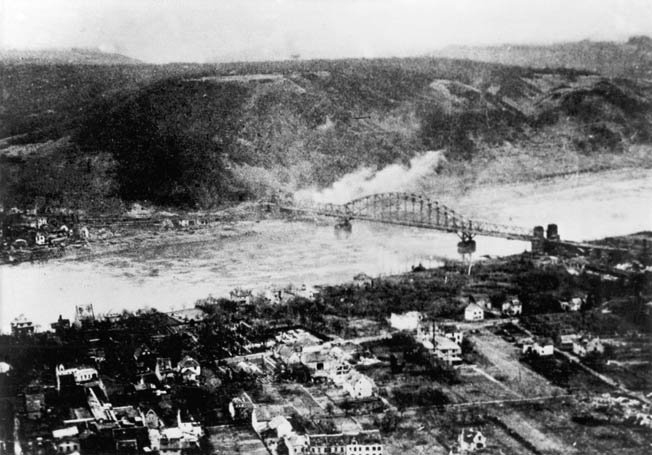
Taking the Heights Above the Ludendorff Bridge
Most of the German defenders had retreated into the dark railroad tunnel running beneath the Erpeler Ley. Huddling with them was a mob of frightened German civilians who had fled into the tunnel to escape the intense firing and shelling. Major Scheller had already taken a bicycle and escaped out the eastern side of the tunnel to report to Hitzfeld’s LXVII Corps headquarters the loss of the bridge to the Americans.
In fact, Captain Willi Bratge had also sent a message to the German high command: “The demolition of the bridge was unsuccessful … and the Americans have crossed!”
Then, Bratge, still in the tunnel, instructed his officers and men to surrender to the Americans. Shortly thereafter, soldiers and civilians raised their hands and headed west across the bridge that was battered but still erect. Upon clearing the railway tunnel, just to be sure, some of the American infantrymen blew apart the master demolition switch with rifle fire.
There was still resistance, however. The crews of the antiaircraft batteries on top of the Erpeler Ley, called Flak Hill by the Americans, were still in place and needed to be neutralized, so Timmermann told Lieutenant Burrows to take 2nd Platoon up the steep slope and clear the Germans off the top.
It was an order easier said than done, as the steepness and the loose rock made the footing treacherous. German fire was also heavy, and Burrows’ platoon from Company B took a number of casualties. Nevertheless, once they reached the top and silenced the enemy, the Americans could look down into neighboring towns and see what looked like the Germans preparing for a counterattack. Artillery fire was called in to disrupt it.
The command post of the bridgehead force was set up in Remagen 200 yards west of the bridge shortly after Timmermann crossed, while Hoge’s CCB headquarters had been established at Birresdorf at noon. The Americans had intercepted German radio traffic ordering a heavy bombing raid on the bridge the following day; however, bad weather caused the mission to be aborted.
More troops were now streaming across the bridge and building up a bridgehead on the eastern bank of the Rhine, but until the crater at the Remagen end of the bridge could be filled in and the planked roadway on the bridge repaired, tanks, trucks, artillery, and jeeps could not be brought across. With daylight rapidly fading, those jobs would have to wait until the next day.
However, some Sherman tanks, narrower than the M26 Pershings, were able to crawl at a slow speed across the bridge, led by infantrymen acting as guides because the bridge’s surface was pockmarked by the day’s earlier fighting. Sergeant William J. Goodson drove the first American tank across the bridge.
By 10 pm, three American rifle companies from the 27th Armored Infantry Battalion, A, B, and C, all of which had many casualties, occupied the Rhine’s eastern shore; Company C moved on Orsberg. This force was sufficient to beat back a German counterattack comprised of engineers and antiaircraft crews near the Erpeler Ley. The counterattacking Germans were carrying 1,000 pounds of explosives with them to destroy the bridge. After the failed counterattack on the east side of the Rhine, Timmerman’s company turned downstream to secure Erpel.
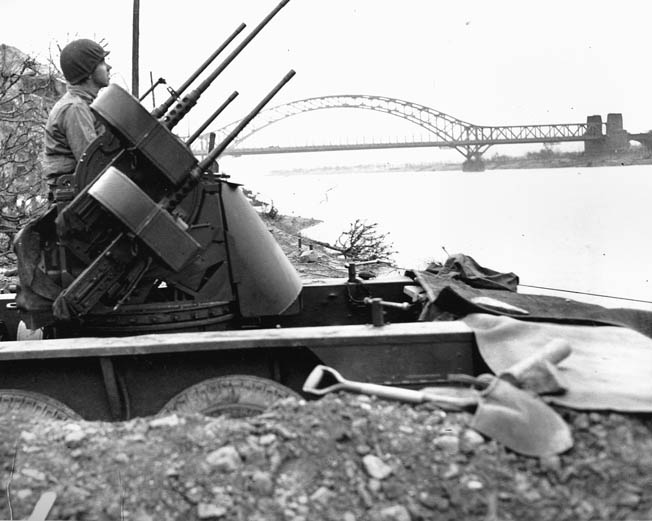
Making Good Use of the Bridge
Repairs to damage caused by the previous charges’ detonations could not be accomplished due to German sniper fire from both banks of the river and would have to wait until darkness descended. Bulldozers then filled in the crater on the western ramp of the bridge while American infantrymen ripped lumber from nearby house exteriors to put a new wooden surface over the rail planks destroyed earlier in the center and eastern spans.
During the night of March 7-8, the roads from Birresdorf to the west and Sinzig to the south were clogged with reinforcements initially of CCB and then III Corps troops being rushed up by General Milliken.
The temporary bridge repairs were completed by midnight and enabled the Americans to establish one-way vehicular traffic. That night, Company A, 14th Tank Battalion, crossed the bridge and set up a roadblock. The 52nd Armored Infantry Battalion then crossed and established its command post at Erpel and took over the northern half of the perimeter on the east side of the Rhine.
At dawn on March 8, the 1st Battalion, 310th Infantry, 78th Infantry Division crossed the river and occupied the high ground south of the bridge around Ockenfels to prohibit the Germans from using this village as an observation post.
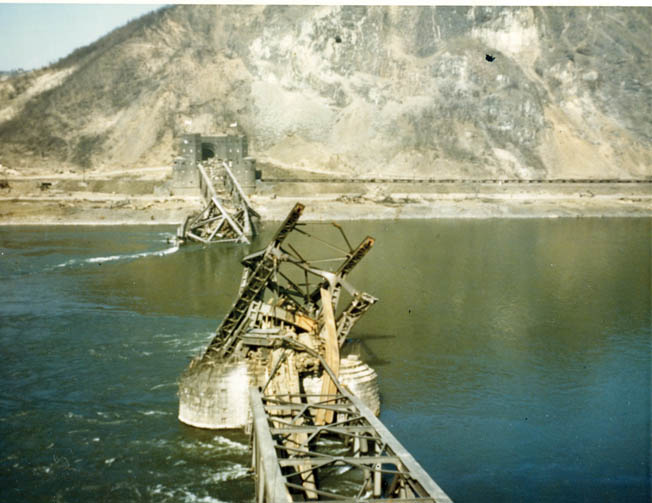
Also that morning, the 14th Tank Battalion, less Company A, crossed and went into mobile reserve. During the remaining daylight hours on the 8th, the 47th Infantry, 9th Infantry Division, and the 311th Infantry, 78th Division, crossed the Rhine and took up perimeter positions to the east and northeast of the 27th and 52nd Armored Infantry Battalions. The 99th Infantry Division was also ordered to exploit the 9th Armored Division’s seizure of the bridge.
These crossings occurred during almost continuous German artillery fire on the bridge and bridgehead. Timmermann’s coup de main had unintentionally carved out a bridgehead one mile deep and two miles wide on the eastern side of the Rhine.
“To Hell With the Planners!”
Once First Army commander Courtney Hodges informed General Omar Bradley, leader of 12th Army Group, about the seizure of the bridge, Bradley said, “Shove everything you can across it, Courtney, and button the bridgehead tightly.”
Bradley had now found the way, by pushing division after division across the Rhine at Remagen, to make sure that he would not lose any of his First Army divisions to other commanders, as he had to British General Bernard Montgomery during the Battle of the Bulge.
Bradley was still fuming at the British general for usurping his role during the Germans’ Ardennes offensive and could only hope for a way to relegate Montgomery and his 21st Army Group to a secondary role in the Rhine crossing operation. Such was the “state of war” among the Allied generals.
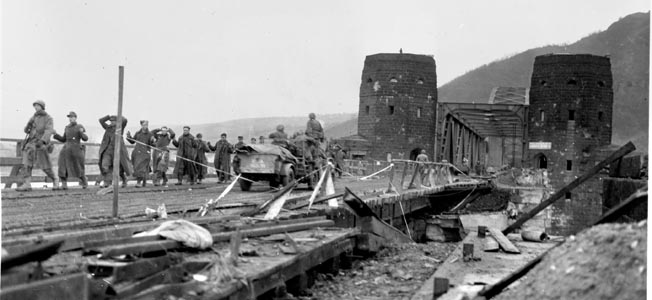
Bradley had yet to inform Eisenhower, who still believed that Remagen was not the ideal position to cross the Rhine. But Maj. Gen. Harold R. Bull, Eisenhower’s G-3, was none too pleased; all the plans called for Montgomery to be the first across the Rhine farther north. Bull told Bradley, “Sure, you’ve got a bridge, Brad, but what good is it going to do you? You’re not going anywhere down there at Remagen. It just doesn’t fit into the plan.”
Bradley shot back, “What in hell do you want us to do? Pull back and blow it up?”
Upon telling Eisenhower about the breakthrough, though, the SHAEF commander responded to Bradley, “Sure, get right on across with everything you’ve got. It’s the best break we’ve had…. To hell with the planners! Sure, go on, Brad, and I’ll give you everything we’ve got to hold the bridgehead. We’ll make good use of it even if the terrain isn’t too good.”
First Army Headquarters, upon being notified of the bridge’s seizure and initial reinforcements, confirmed the decision to exploit the bridgehead, and the area suddenly swarmed with units to defend the hard-won prize. Hodges immediately attached the 7th Armored Division to III Corps and would also send to the bridgehead the 2nd Infantry Division from V Corps. Also, a 90mm antiaircraft artillery battalion, a treadway bridge company, and a DUKW (amphibious truck) company were dispatched to augment III Corps’ assets at the Remagen bridgehead.
Other considerations were the need for artillery support, the protection of the bridge against enemy air action—including V-2 rockets—and sabotage. The construction of adjoining bridges at the Remagen crossing site was also of high priority.
As for artillery, one 4.5-inch gun battalion, one 155mm gun battalion, and one 8-inch howitzer battalion were trucked into position, ready to deliver fire. In the early hours of March 8, the 482nd Anti-Aircraft Artillery Automatic Weapons Battalion also had established defensive positions near the Remagen bridge.
In addition, Hodges’ First Army staff was assured that air cover would be provided from any base on the Continent or in the United Kingdom from which planes were able to sortie, weather permitting. Milliken’s III Corps headquarters set up the priority for the movements of troops available west of the Rhine as rapidly as they could be disengaged and established a tactical command post at Remagen especially for the control of rapidly emerging traffic circulation problems on the Ludendorff Bridge.
Keeping the Bridge In Tact
East of the Rhine, the enemy took no concerted actions. No counterattacks were launched, and no organized defenses were encountered. However, the Luftwaffe attempted 10 raids over the bridge with 10 aircraft, eight of which were Stuka dive bombers.
By the afternoon of March 8, the 482nd Anti-Aircraft Artillery Battalion had three batteries at the bridge site, with three platoons on the east and three platoons on the west bank of the river, while the 413th Anti-Aircraft Artillery Battalion went into positions on the west bank and shot down eight attacking German aircraft. Units were also employed to ensure that the bridge would be protected from floating mines, demolition-carrying swimmers, and explosives-laden river barges.
On March 9, the third day of the bridgehead operation, German opposition east of the Rhine became more tenacious, notably from elements of the 11th Panzer Division. In contrast, on the western bank of the Rhine all German resistance had ceased.
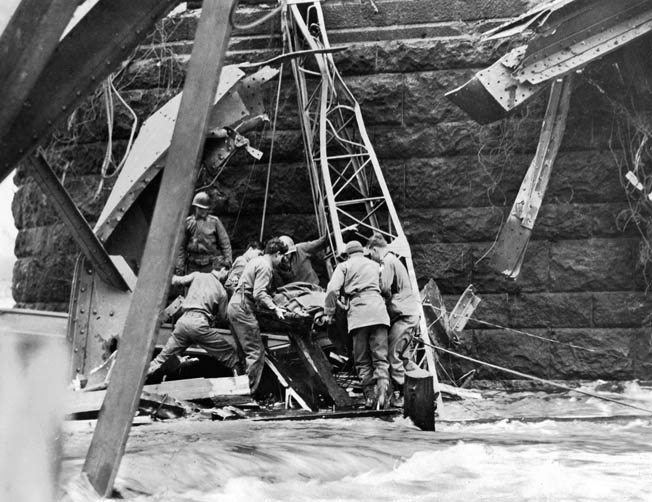
The III Corps Engineers was directed to assume control of all engineer activity at the bridge site, relieving 9th Armored Division engineers of that responsibility. Two ferries were in operation, principally to remove the wounded and keep the bridge open for combat vehicle traffic. A treadway and pontoon bridge upstream were now under construction along with log and net booms to protect the bridge from water-borne demolitions and obstacles.
As this third day ended, the bridgehead had been reinforced by the 308th Infantry Regiment and the remainder of the 310th Infantry Regiment, along with the 60th Infantry Regiment and additional antiaircraft artillery protection. The antitank defense of the bridgehead had been bolstered by the tank destroyers accompanying the regimental combat teams.
Although no U.S. artillery was as yet operational on the east side of the Rhine, divisional and corps artillery supported the operation from their positions on the west bank of the river.
The German high command did not sit idly by after the capture of the Ludendorff Bridge. Field Marshals Rundstedt and Model both called for immediate counterattacks; however, a shortage of tanks, fuel, and ammunition curtailed such plans.
Instead of tank and infantry counterattacks, artillery fire from all types of guns commenced battering the bridgehead almost immediately after its seizure. The barrage included the biggest German artillery weapon, the 540mm railway-mounted siege mortar Mörser Karl, weighing 130 tons. After firing a few 4,400-pound shells, it had to be withdrawn for repairs.
During the early afternoon of March 9, a direct hit on an American truck carrying ammunition across the bridge caused such extensive damage that further traffic across it had to be curtailed for several hours.
The Luftwaffe also mounted over 400 sorties against the bridge, including the new Me-262 fighter jets and older Stukas, but the Allied antiaircraft defenses were too dense; over 700 guns surrounding the bridge threw up a curtain of lead at the planes.
American fighters based in France along with RAF Hawker Tempest fighters stationed in Holland also defended the bridge against the nine days of Luftwaffe air assaults. Over 11 V-2 rockets were launched against the bridge from Bellendoorn, Holland, without any scoring a hit on or near the structure (the closest was 300 yards away). This was the only occasion on which the V-2 was employed as a tactical weapon during the war.
On March 13, in an effort to protect the bridge against enemy waterborne attack, V Corps, commanded by Maj. Gen. Clarence R. Huebner, was informed that it was vital to use the utmost vigilance along the river to prevent enemy swimmers, mines, boats, or midget submarines from moving downstream.
III Corps also dispatched technical experts to the bridge zone, where installation of a cable across the river served as an antitorpedo boom. One platoon of Canal Defense Light (CDL) M3 Lee tanks from Company C, 738th Tank Battalion was instructed to maintain observation and protection on the river 24 hours per day.
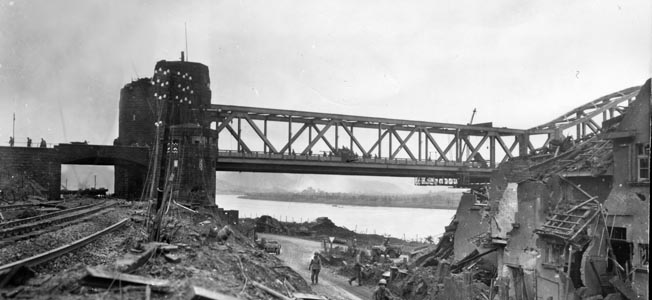
Collapse of the Ludendorff Bridge
The Americans continued to repair the bridge for nine days, even though quickly built treadway and pontoon bridges were by now carrying much of the vehicular traffic across the river. The construction of the treadway bridge, the first tactical bridge to be built across the Rhine since the Napoleonic era, began two days after the seizure of the Ludendorff Bridge, while the bridge site was under heavy and continuous artillery and air attack.
Then tragedy struck. Weakened by the intense fighting, the near misses, and the heavy vehicular traffic, at about 3 pm on March 17 the old bridge collapsed as some rivets spontaneously snapped and a vertical hanger of the bridge fell. The bridge then seemed to fold onto itself before pitching into the Rhine at a cost of 28 dead and 63 injured American engineers.
The loss of the bridge did not halt the American tide pouring into Germany. Both the heavy pontoon and treadway bridges were in operation to carry on the troop or supply movements, and DUKWs, LCVPs (Landing Craft Vehicle, Personnel), and ferries were used to augment the bridges’ traffic.
The loss of the Ludendorff Bridge, however, proved disastrous for four German junior officers, including Major Hans Scheller, who had failed to demolish the bridge on March 7. On Hitler’s personal order, the four were summarily tried and executed for cowardice with a coup de grace prior to burial in an unmarked shallow grave in the Westerwald. This sentence was carried out despite the fact that Field Marshal Model had stated that they were completely innocent.
Captains Bratge and Friesenhahn, who had been captured in the tunnel by Lieutenant Timmermann and his Company A infantrymen, were tried in absentia. Bratge was sentenced to death, and Friesenhahn was acquitted. The punishments were moot as they were now both Allied POWs.
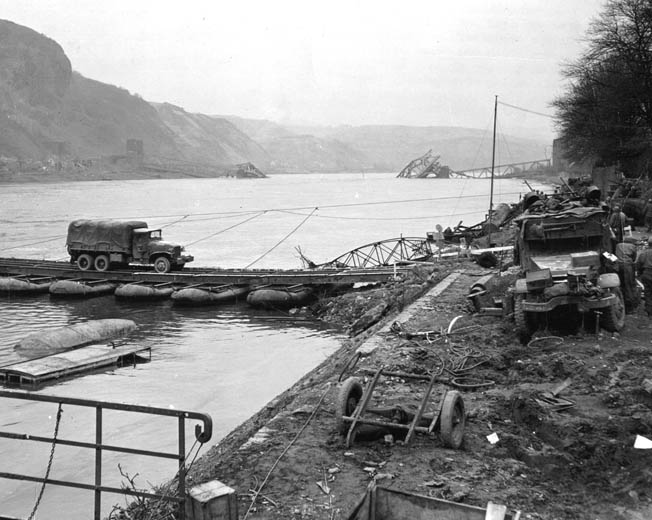
Within a week, eight U.S. Army bridges would span the river at Remagen, helping maintain a previously unimaginable bridgehead in this area 25 miles wide by eight miles deep. For the initial 18 days, the expansion of the bridgehead was relatively slow, with advances made on foot and measured in feet and yards.
A Battle of Initiative Over Planning
It has been said that no poorer place could have been selected for a crossing; the mountainous country not only restricted the use of armor, but it was extremely difficult for the infantry to assault. The rugged, forested hills gave the enemy good observation and formed a natural fortress that he used skillfully. Although German forces were weak initially, the arrival of several divisions, beginning with the understrength 11th Panzer from Dusseldorf on March 9, enabled the Wehrmacht to conduct an aggressive defense in which numerous and determined counterattacks played a large part.
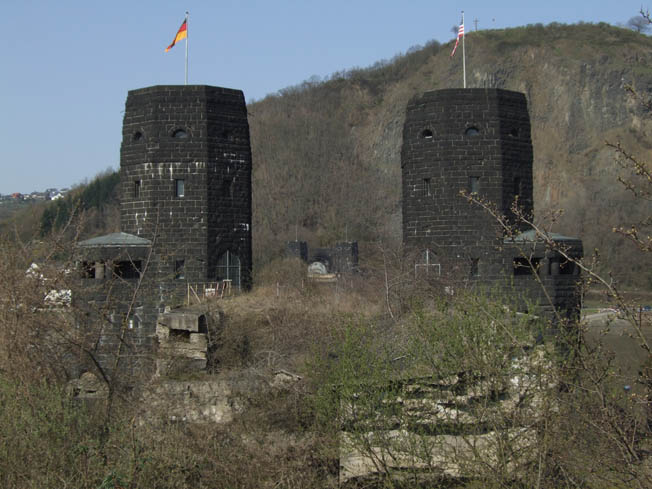
This may explain why Eisenhower, who was initially enthusiastic about the bridge’s seizure, later became distinctly cold about the whole enterprise. It was not until many days of hard fighting had driven the enemy across the Cologne-Frankfurt autobahn that the 3rd, 7th, and 9th Armored Divisions were able to break through to make the spectacular advances of the last days of March 1945.
According to Maj. Gen. John W. Leonard, commander of the 9th Armored Division, “The operation [Remagen bridgehead] is an outstanding proof that the American principles of warfare, with emphasis on initiative, resourcefulness, aggressiveness, and willingness to assume great risks for great results, are sound. The commander must base his willingness to assume those great risks upon his confidence in his troops.”
Heroes were created that March day. Lieutenants Timmermann and Mott, along with Sergeants DeLisio and Drabik, were awarded Distinguished Service Crosses for their actions at the Remagen bridge. And every man who crossed the bridge under fire, even those whose names were unknown, became a hero to the American public.
To Mary Timmermann, however, the fact that her son was uninjured was the most important thing.
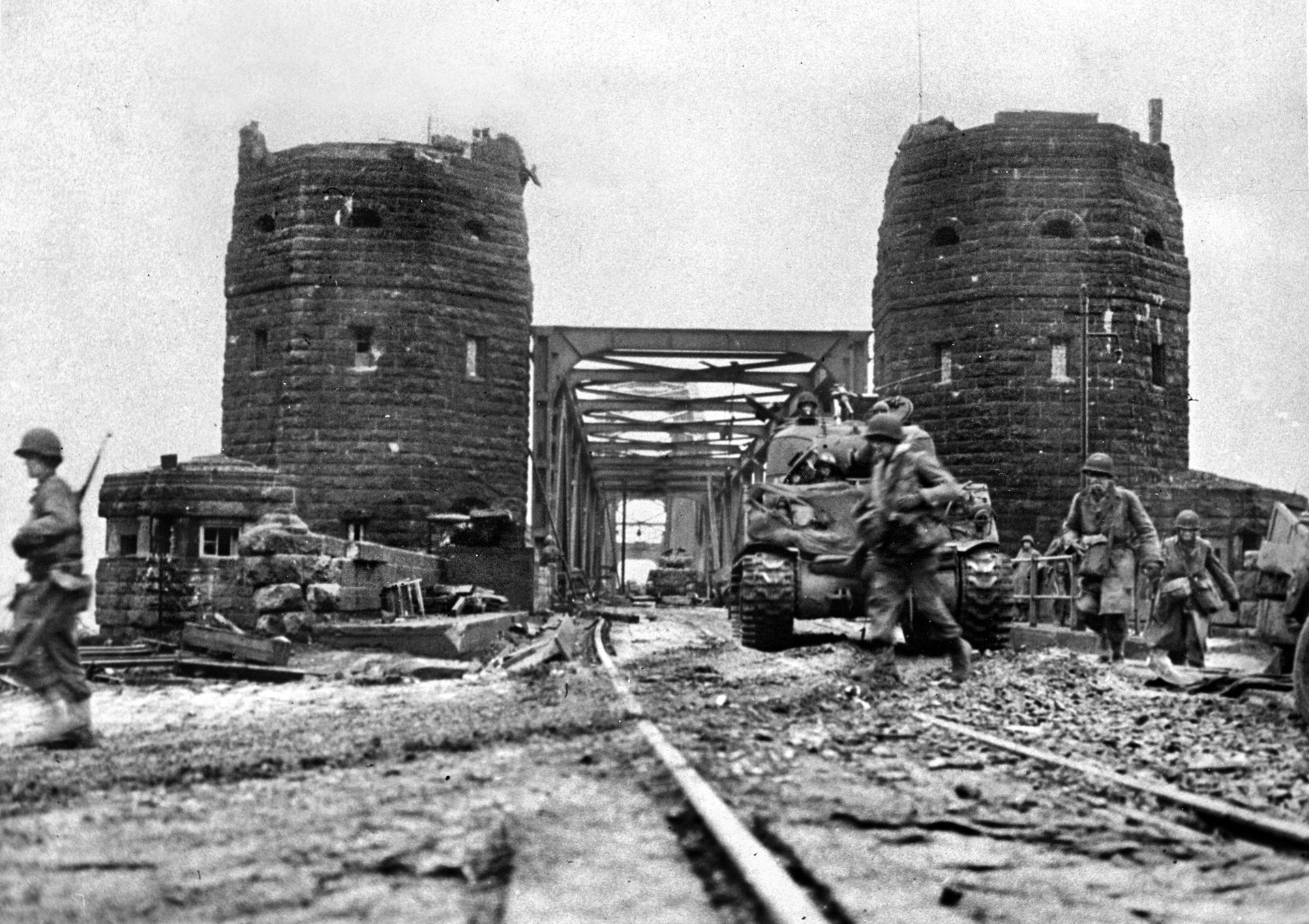
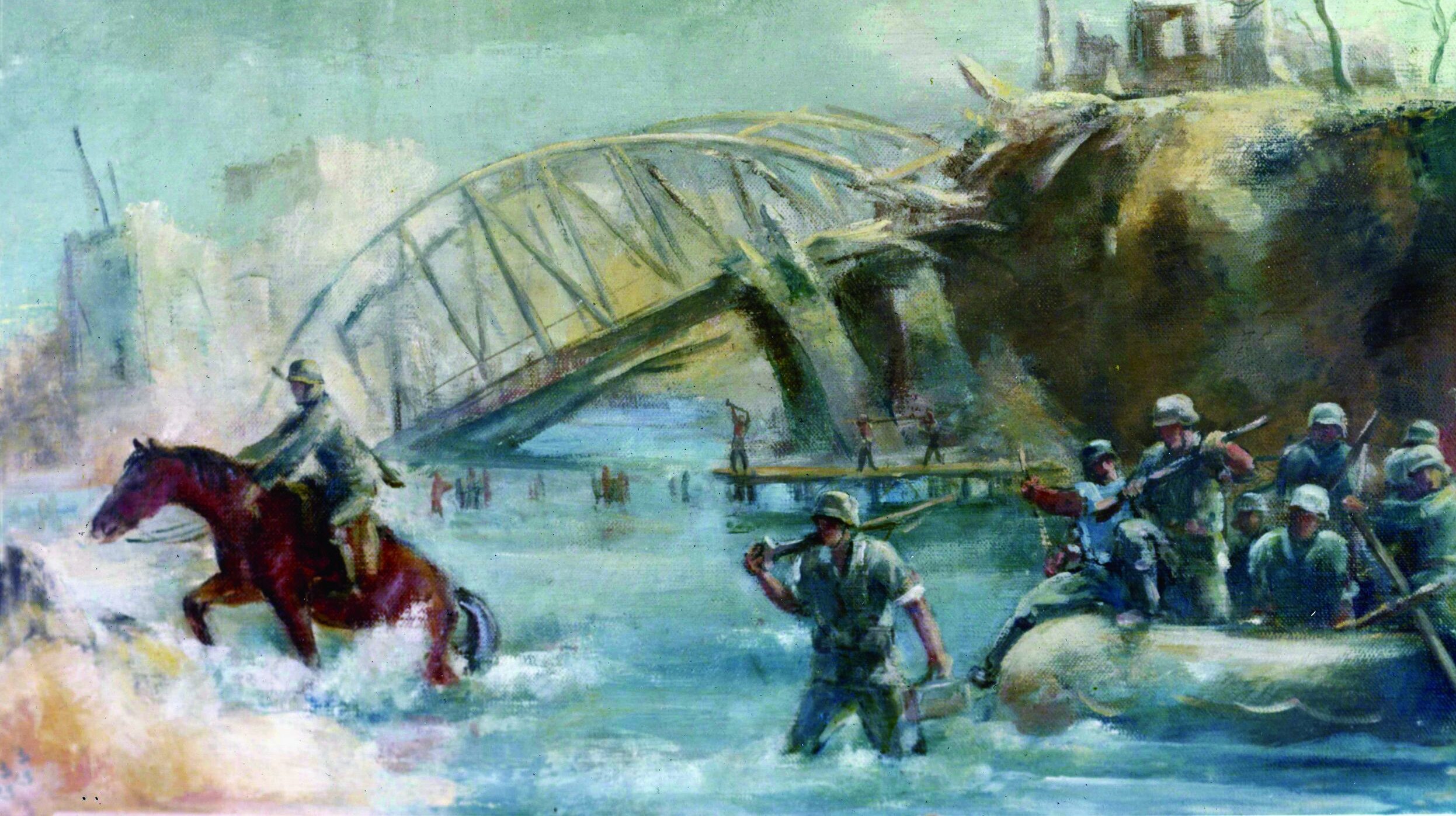
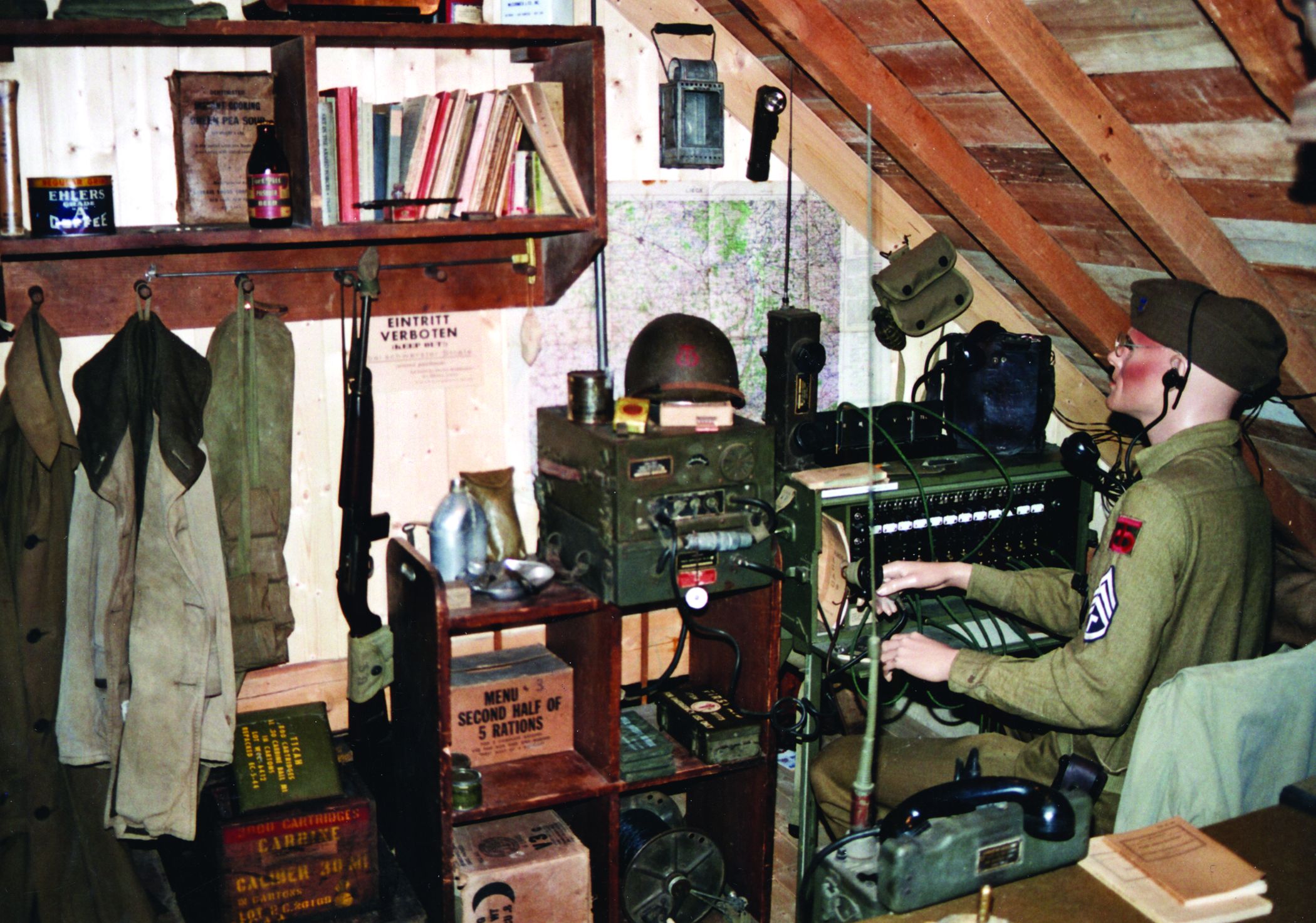
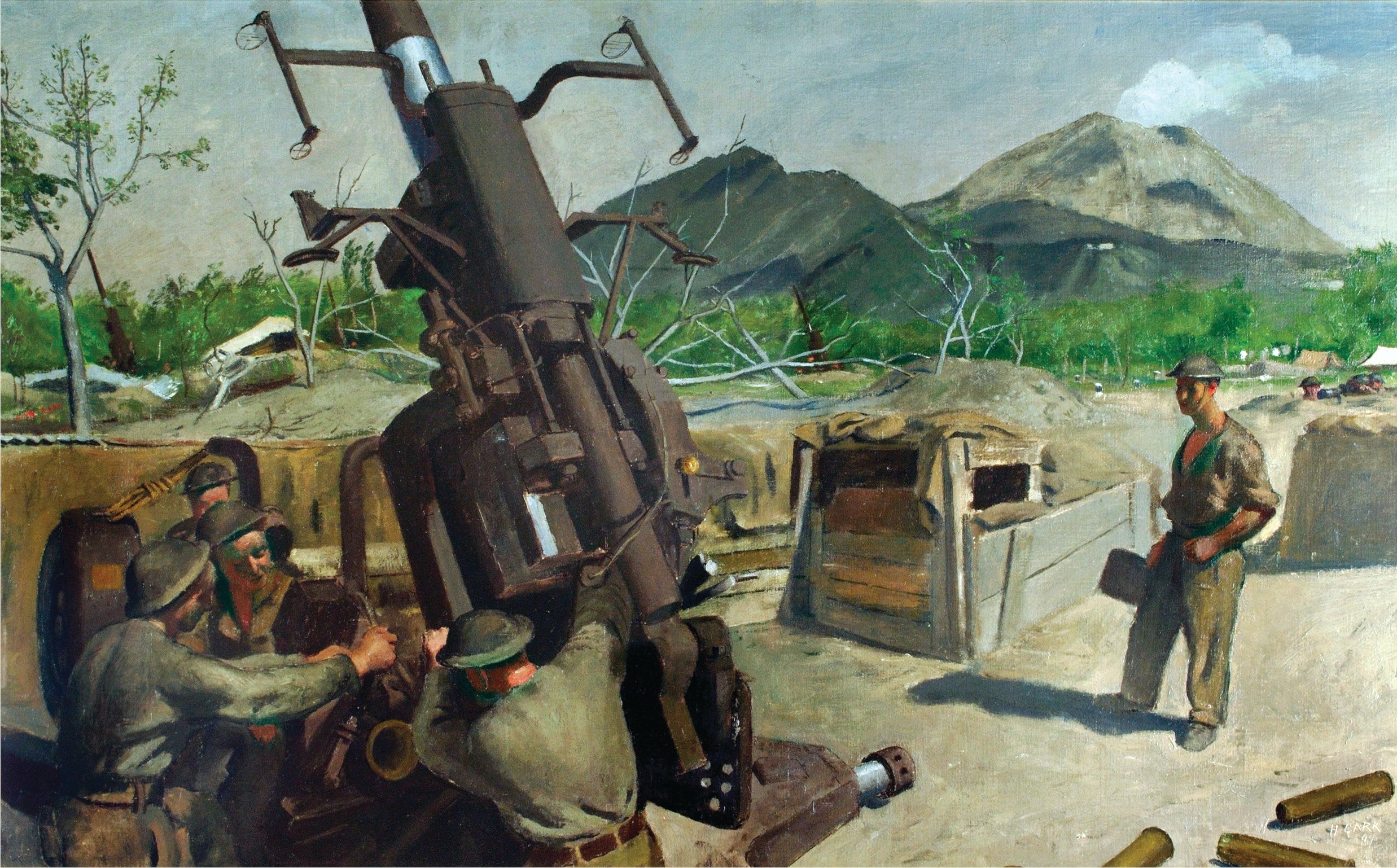
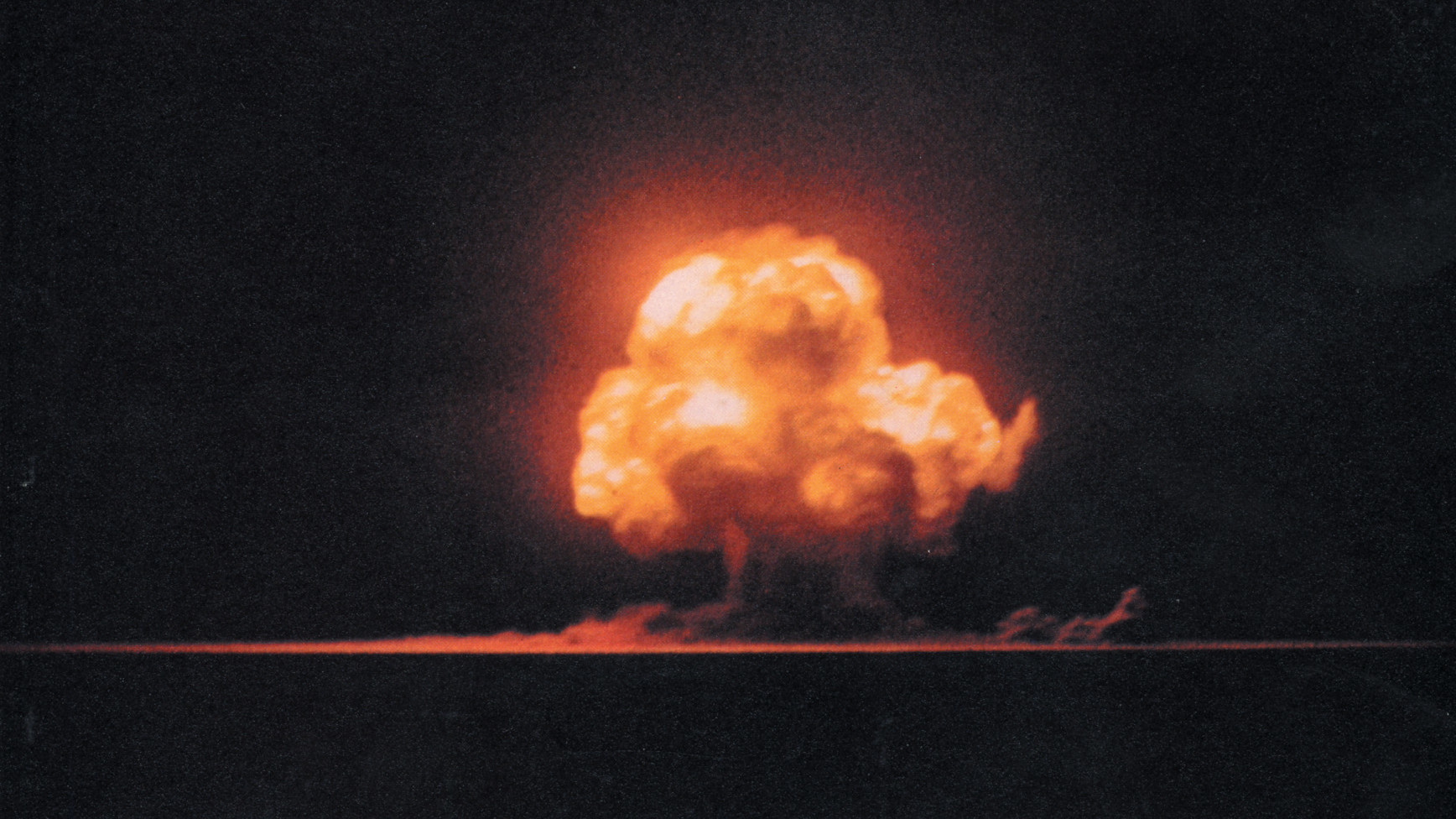

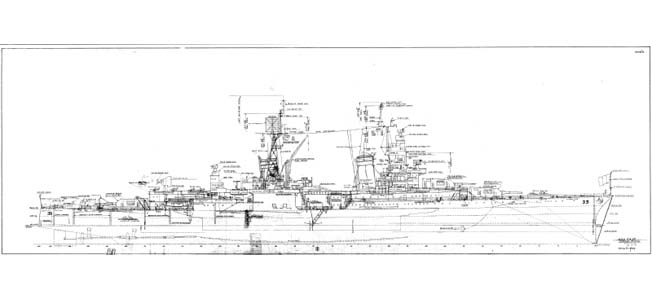
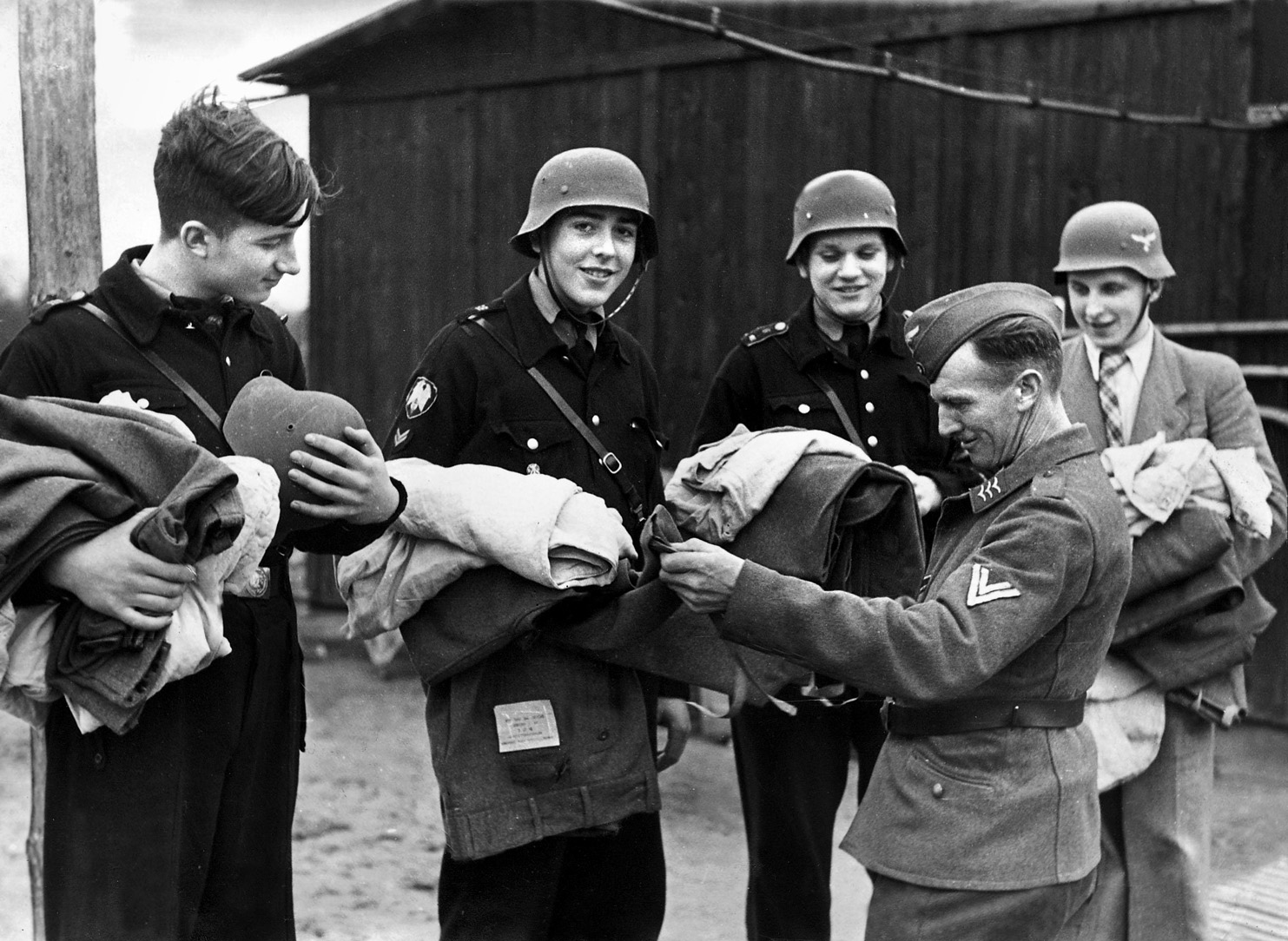
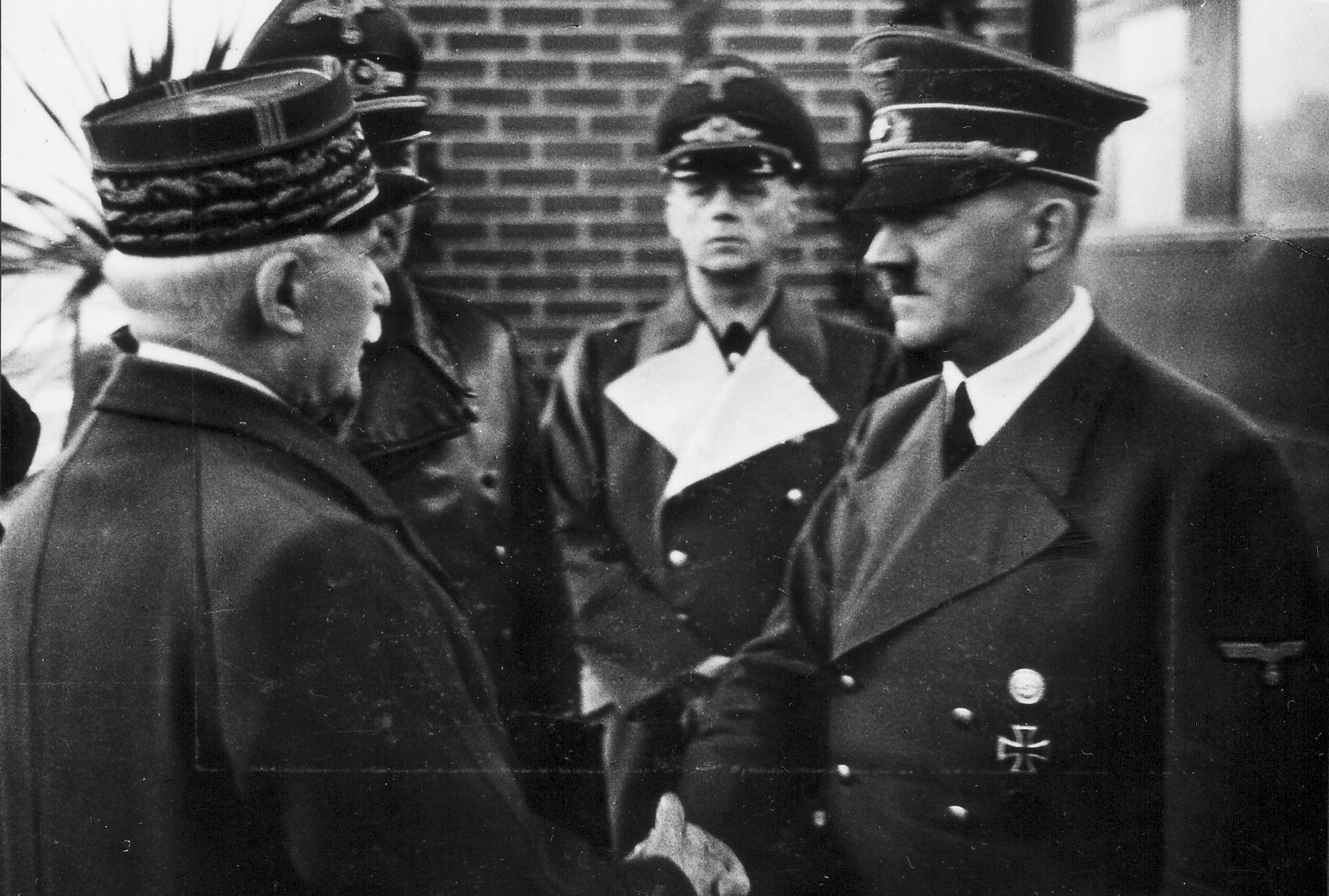
PFC Robert W. Elsenheimer, Serial No. 42 097 64352nd Armored Infantry Battalion, HQ & HQ Co. Reconnaissance Platoon, was on the third truck to cross the Rhine per his telling to multiple family members.
What an amazing Feat of Arms, an amazing leadership by Eisenhower, Bradley, Hodge, Timmerman and Drabik.
I would like to obtain permission to use the photo of Pfc. Richard Schrame with his Quad-50 AAA at the Rhine. Do you know how I could obtain approval? Thank you.
We don’t own that image and therefore are not able to provide permission. However, I believe we obtained that photo from the U.S. National Archives, so it is generally considered to be in the public domain.